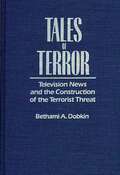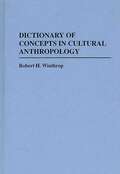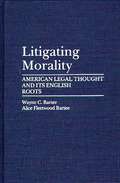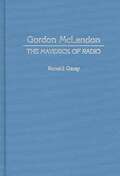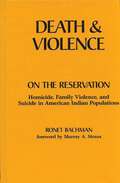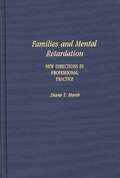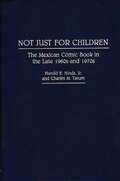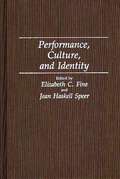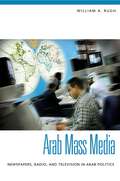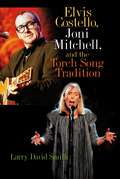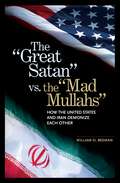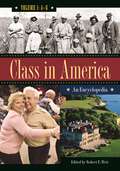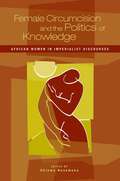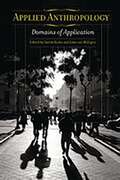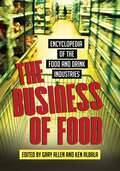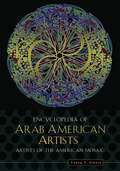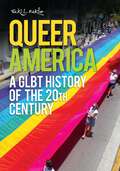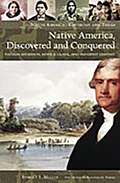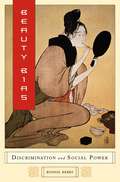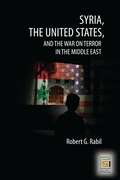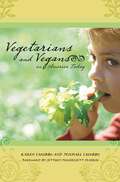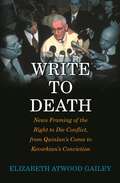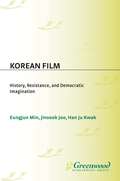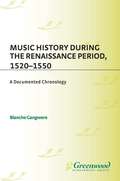- Table View
- List View
Tales of Terror: Television News and the Construction of the Terrorist Threat (Media and Society Series)
by Bethami A. DobkinConventional research suggests that news coverage of terrorism is a tool of the terrorist to gain public support and recognition. Based on an analysis of more than 200 evening newscasts aired during the first six years of the Reagan administration, Tales of Terror offers a detailed account of the ways in which news media escalate public panic about terrorism and encourage support for specific U.S. policy objectives, rather than build sympathy for terrorists. Bethami Dobkin explores similarities between news media and government portrayals of terrorism, combining textual criticism with an interpretation of official U.S. policy statements, and argues that government depictions and news presentations of terrorism reproduce an ideology that supports military strength and intervention.Dobkin examines several specific features of news coverage: the dramatic format of television news and the political interests that this format serves; the narrative construction of enemies by television journalists and public officials and the political significance of the terrorist label; the use and significance of testimony, particularly that of people affected by crisis; the mutual exploitation of political crisis by both television news producers and public officials; the function of journalism in shaping the conduct of public diplomacy and public perceptions of foreign conflict; and the creation of consensus about the need for military responses to political violence. This revealing study will be of particular interest to scholars of communications and political science.
Dictionary of Concepts in Cultural Anthropology (Reference Sources for the Social Sciences and Humanities)
by Robert H. WinthropThe field of cultural anthropology describes and interprets the thought and behavior of contemporary and near-contemporary societies. Inherently pluralistic, it offers a framework in which the distinctive perspectives of each cultural world can be appreciated. Robert Winthrop's dictionary describes the major concepts that have shaped the discipline, both historically and theoretically. It sets modern anthropology in its proper context within the broader intellectual tradition.Eighty entries review the key concepts--culture, race, nature, symbolism, adaptation, the primitive, etc.--that have established the fundamental problems and issues, guided research, and served as the focus for debate in key areas of the discipline. The entries which range from 2,000 to 6,000 words in length, are both thorough in treatment and contemporary in relevance. Some entries are primarily of historical significance while others describe recent developments. Each entry contains an annotated bibliography and a guide to additional reading on the subject. While this is not primarily a technical lexicon, many terms have been glossed and explained. Designed to be useful to students of anthropology, this dictionary will assist those in other disciplines to find their way through the anthropological labyrinth.
Litigating Morality: American Legal Thought and Its English Roots
by Alice Fleetwood Bartee Wayne C. BarteeThis volume is a thematic study in legal history that uses past and present landmark court cases to analyze the legal and historical development of moral regulatory policies in America and resulting debates. Using a critical variable approach, the book demonstrates how different elements of the legal process have historically influenced the litigation of various moral issues. Five moral policies are included: abortion, sodomy, pornography, criminal insanity, and the death penalty. The book's framework for analysis uses examples from English legal history and links them to American cases, demonstrating how moral regulatory policies are impacted by the legal process: by laws, by judges and juries, by legal scholars, and by attorneys.Following a brief introduction, Chapter 1 examines how protagonists in the bitter moral and legal controversy over abortion in America have sought to fortify their positions with the views of prominent English legal authorities. The authors discuss the role of English legal scholars in court opinion and oral arguments in Webster and in Roe v. Wade, and debates Roe's interpretation of the English legalists. Chapter 2 describes how attempts to expand a right of privacy under the federal Constitution to include sodomy failed the test for common law rights (Rights of Englishmen) in Bowers v. Hardwick (1986), and includes a history of sodomy in early English and American law. Chapter 3 discusses pornography standards and laws, highlighting the history of legal actions taken against Memoirs of a Woman of Pleasure in both England and the U.S., demonstrating the role of precedent in American judicial efforts to define pornography. In Chapter 4, which deals with the criminal insanity defense, the influential role of the defense attorney on case outcomes is illustrated in cases such as England's McNaughton case (1843) and America's Hinckley case (1982). Chapter 5 deals with cruel and unusual punishment throughout U.S. and English history. The book ends with an epilogue which ties together the idea of the American legal process as an inherited English process, reiterating how decisionmakers continually mine the past to find traditions and sources of moral values for justifying or criticizing current laws and policies.
Gordon McLendon: The Maverick of Radio (Contributions to the Study of Mass Media and Communications)
by Ronald GarayStudents and others interested in radio history will be intrigued by this fast-paced biography of Gordon McLendon's career in the radio industry, touching also on his work in motion pictures and involvement in Texas politics.Following a glimpse into his childhood, education, and military career, Ronald Garay describes McLendon's station ownership and management in Palestine, Texas; the development of a major network, the Liberty Broadcasting System; his live and recreated baseball and football programs; and his skirmishes with the major league baseball establishment. Much attention is given to how McLendon re-invented radio and competed with television and print media through his Top 40 music hits, disc jockey programming, and the use of local news. Important concerns regarding station trafficking, editorializing, and public interests are considered as well in this extraordinary book.
Death and Violence on the Reservation: Homicide, Family Violence, and Suicide in American Indian Populations
by Ronet BachmanThis volume is the first major attempt to systematically examine the etiology of violence in American Indian communities. Using fieldwork as well as quantitative and qualitative research, Bachman first presents an overview of American Indians from historical and contemporary perspectives, before she focuses specifically on violence and its causes. Homicide, suicide, and family violence are analyzed in depth, and the destructive impacts of alcohol and other addictive substances are documented.Dr. Bachman effectively uses personal stories and narratives given by American Indians to illustrate the living reality behind the statistics she presents. She concludes with a variety of policy recommendations that will be of interest not only to policymakers, but also to academic researchers and students in criminology, ethnic relations, sociology, and anthropology.
Families and Mental Retardation: New Directions in Professional Practice
by Diane MarshTraditional pathology models do not provide a satisfactory framework for professional practice with families of people with mental retardation. Families and Mental Retardation is written from the perspective of a competence paradigm for professional practice, which offers a constructive alternative to the more prevalent pathology models of the past. The goal of professional practice is to empower families in coping with the catastrophic stressor of mental retardation. Such an approach recognizes the strengths and resources of families, which have often been minimized in the past, and fosters new collaborative modes of family-professional relationships.Unique features include a consideration of life-span and family system and subsystem perspectives, as well as the inclusion of powerful personal accounts of family members. The volume is likely to be of special value to mental health and health care professionals, who often receive little training in mental retardation or family-professional relations, and who tend to apply a pathology model. In contrast, a competence paradigm is more prevalent in education.
Not Just for Children: The Mexican Comic Book in the Late 1960s and 1970s (Contributions to the Study of Popular Culture)
by Harold E. Hinds Charles M. TatumThis pioneering study presents an overview of the Mexican comic book industry, together with in-depth studies of the best selling Mexican comic books of the 1960s and 1970s. Most of the popular superhero, adventure, humor, romance, political, detective, and Western comic books are described and analyzed in detail, and then discussed in terms of how they reflect both Mexican and United States cultures. The study concludes with a critical discussion of the media imperialism hypothesis' applicability to the Mexican comic book.The comic book is Mexico's most popular print medium, read by all ages and socio-economic groups. Many may be surprised to learn that, in Mexico, Mexican comic books far outsell U.S. comic books in Spanish translation. The Mexican comic book is not a clone of its U.S. model, but rather a hybrid product that mixes U.S. forms and conventions with Mexican content. This work is a major contribution to the understanding of contemporary Mexican culture.
Performance, Culture, and Identity
by Elizabeth C. Fine Jean HaskellThis volume is based on the premise that artistic performance is epistemological, a way of knowing self, culture, and other. The nine essays in this book, based on a broad range of ethnic, racial, and gender groups, share a common interest in exploring how performance reveals, shapes, and sometimes transforms personal and cultural identity. Editors Fine and Speer begin by examining the interdisciplinary roots of performance studies and the role of performance studies in the field of communication. They also discuss the power of performance to shape personal and cultural identity.The first two chapters explore the ritual nature of performance in two different cultural contexts: an African-American church service and an Appalachian storytelling event of the legendary Ray Hicks. In both arenas, the performers act as shamans, transporting the audience from their everyday, secular lives to the higher ground of the mythic spheres of heroic and fantastic events. The next three chapters discuss the notion of place and performance in various landscapes--the English countryside, the Blue Ridge Mountains, and the farmland of the Midwest. Through analysis of the speech and songs of a modern Sussex yeoman, the ghost tales of Appalachian storytellers, and the narratives of Midwest farmers coping with hard times, the authors reveal a variety of ways in which narrative performances function to preserve people's relationship with the land. The last four chapters share a focus on women as storytellers. One chapter offers a feminist critique of personal narrative research and challenges normative assumptions about the storytelling behavior of women. Another chapter interprets a narration of a Galician woman's typical day to reveal how the performance expresses deeply held attitudes and beliefs of her cultural community. Words are not the only medium that women use to tell their stories. The next chapter examines the story cloths of Hmong women refugees from Laos as intercultural and dialogical performances. The last chapter explores self-discovery and identity in the storytelling of a woman in the last years of her life. This volume is particularly representative of the ways in which communication scholars approach performance studies, but will also interest researchers and students of folklore, anthropology, sociology, theatre, and related disciplines.
Arab Mass Media: Newspapers, Radio, and Television in Arab Politics
by William A. RughSince September 11, 2001, and the wars in Afghanistan and Iraq, many television viewers in the United States have become familiar with Al Jazeera as offering an alternative take on events from that presented by mainstream U.S. media, as well as disseminating anti-American invective. Westerners have tended toward simplistic views of Arab newspapers, radio, and television, assuming that they are all under government control and that freedom of press is non-existent. William A. Rugh, a long time observer of the Arab mass media, offers a more nuanced picture of the Arab press as it relates to the political situation in the Arab world today.Although governmental influence over the media is stronger in the Middle East than in Europe or the United States, Rugh argues that there is more diversity in the Arab media than most people in the West realize. In reality, the Arab media are coming to reflect the diversity and wide range of opinions of those within the Arab world itself. In particular, the advent of privately owned Arab satellite television in the 1990s has led to significant liberalization of the media throughout the region. Rugh concludes that a democracy of ideas and voices is slowly growing in the Arab world, and he remains guardedly optimistic about the positive role the Arab media can play in processes of democratization and nation-building.
Elvis Costello, Joni Mitchell, and the Torch Song Tradition
by Larry David SmithThe torch song has long been a vehicle for expression—perhaps American song's most sheerly visceral one. Two artists in particular have built upon this tradition to express their own unique outlooks on their lives and the world around them. Joni Mitchell, Elvis Costello, and the Torch Song Tradition combines biographical material, artist commentary, critical interpretation, and selected exemplars of the writers' work to reveal the power of authorship and the creative drive necessary to negotiate an artistic vision in the complicated mechanisms of the commercial music industry. Author Larry David Smith, as in his Bob Dylan, Bruce Springsteen, and American Song, considers the complicated intersection of biography, creative philosophy, artistic imperative, and stylistic tendencies in the work of both Joni Mitchell and Elvis Costello—two songwriters with seemingly nothing in common, one famously confessional and one famously confrontational. Yet, as Smith shows so incisively, they are two personalities that prove fascinatingly complementary.Mitchell and Costello both yielded bodies of work that are cohesive, coherent, and rich in meaning. Both have made historic contributions to the singer-songwriter model, two rebellious respones to the creative and commercial compromises associated with their chosen field, and two distinct thematic responses to the torch song tradition. Smith examines these responses, offering a unique and invaluable exploration of the craft of two of the last century's most towering musical figures.
The Great Satan vs. the Mad Mullahs: How the United States and Iran Demonize Each Other (Non-ser.)
by William O. BeemanThe United States and Iran have been estranged for 25 years. They have carried out a mutual process of demonization that is unprecedented in modern history, based on cultural hot buttons that have the power to galvanize the populations of both countries. Iranian leaders have characterized the United States as the Great Satan—an evil corruptor that pollutes society and destroys personal morality. American leaders characterize the members of the current government of the Islamic Republic of Iran as Mad Mullahs, wild-eyed and irrational. Giving a thorough account of the background of U.S.-Iranian relations, Beeman claims that the current accusations of both Iran and the United States are baseless, consisting largely of public invective and symbolic rhetoric according to their own mythologies of evil.American leaders characterize the members of the current government of the Islamic Republic of Iran as Mad Mullahs, wild-eyed and irrational. They accuse them of fomenting the hostage crisis, in which American embassy personnel were held for 444 days at the end of the Carter administration, dealing a severe blow to U.S. national honor. The Bush administration has further accused the Iranians of being part of an Axis of Evil on the basis of their alleged support of terrorists, oppression of women and minorities, and development of nuclear weapons. Giving a thorough account of the background of U.S.-Iranian relations, Beeman claims that the current accusations of both Iran and the United States are baseless, consisting largely of public invective and symbolic rhetoric according to their own mythologies of evil.
Class in America [3 volumes]: An Encyclopedia [3 volumes]
In the United States, social class ranks with gender, race, and ethnicity in determining the values, activities, political behavior, and life chances of individuals. Most scholars agree on the importance of class, although they often disagree on what it is and how it impacts Americans. This A-Z encyclopedia, the first to focus on class in the United States, surveys the breadth of class strata throughout our history, for high school students to the general public. Class is illuminated in 525 essay entries on significant people, terms, theories, programs, institutions, eras, ethnic groups, places, and much more.This useful set is an authoritative, fascinating source for in-demand information on key aspects of our culture and society and helps researchers to narrow down a broad topic. Class is revealed from angles that often intersect: through history, with entries such as Founding Fathers, the Industrial Revolution, Westward Expansion; through economics, with entries such as Dot.com Bubble, Robber Barons, Chicago School of Economics, Lottery, Wage Slaves, Economic Equal Opportunity Act, Stock Market, Inheritance Taxes, Wal-Mart, Welfare; through social indicators such as Conspicuous Consumption, the Hamptons, WASP, Homelessness, Social Climbing; through politics with entries such as Anarchism, Braceros, Heritage Foundation, Communist Party, Kennedy Family; and through culture through entries such as Country Music, The Great Gatsby, Television, and Studs Terkel. Class is also approached from ethnic, sexual, religious, educational, and regional angles. Special features include an introduction, timeline, suggested reading per entry, cross-references, reader's guide to topics, and thorough index. Sample entries: Immigration, Education, Labor Movement, Pink-Collar Workers, AFL-CIO, Strikes, Great Depression, Jacob Riis, Literature, the Rockefellers, Slavery, Music, Academia, Family, Suburbia, McMansions, Taxation, Segregation, Racism, Ivy League, Robber Barons, Philanthropists, Socialites, Religion, Welfare, the American Dream, Dot.com Millionaires, Equal Opportunity, Founding Fathers, Wage Slaves, Industrial Revolution, Capitalism, Economics, Appalachia, Horse Racing, Gender, Communist Party, Country Clubs, Religion, American Indians, Conspicuous Consumption, Studs Terkel, Film, Class-Consciousness, Work Ethic, Media, Television, Puritans, Homelessness, Status Symbols, Assimilation/Melting Pot, Art, Westward Expansion, Poverty, The Great Gatsby, Stock Market, Working Poor, Gated Communities, the Hamptons, Social Climbing, Crime, Lottery, Elitism, WASP, American Dream, Noam Chomsky, Fortune Magazine
Female Circumcision and the Politics of Knowledge: African Women in Imperialist Discourses (Non-ser.)
by Obioma NnaemekaHeated debates about and insurgencies against female circumcision are symptoms of a disease emanating from a mindset that produced hierarchies of humans, conquered colonies, and built empires. The loss of colonies and empires does not in any way mitigate the ideological underpinnings of empire-building and the knowledge construction that subtends it. The mindset finds its articulation at points of coalescence. Female circumcision provided a point of coalescence and impetus for this articulation. Insisting that the hierarchy on which the imperialist project rests is not bipolar but multi-layered and more complex, the contributions in this volume demonstrate how imperialist discourses complicate issues of gender, race, and history. Nnaemeka gives voice to the silenced and marginalized, and creates space for them to participate in knowledge construction and theory making.The authors in this volume trace the travels of imperial and colonial discourses from antecedents in anthropology, travel writings, and missionary discourse, to modern configurations in films, literature, and popular culture. The contributors interrogate foreign, or Western, modus operandi and interventions in the so-called Third World and show how the resistance they generate can impede development work and undermine the true collaboration and partnership necessary to promote a transnational feminist agenda. With great clarity and in simple, accessible language, the contributors present complex ideas and arguments which hold significant implications for transnational feminism and development.
Applied Anthropology: Domains of Application (Non-ser.)
by Satish Kedia John van WilligenApplied Anthropology: Domains of Application, edited by Satish Kedia and John van Willigen, comprises essays by prominent scholars on the potential, accomplishments, and methods of applied anthropology. Domains covered in the volume include development, agriculture, environment, health and medicine, nutrition, population displacement and resettlement, business and industry, education, and aging. The contributors demonstrate in compelling ways how anthropological knowledge, skills, and methodologies can be put to work in addressing social, economic, health, and technical problems facing societies today. With their genuine commitment to protecting the diversity and vitality of human communities, applied anthropologists working in real-life settings have and will continue to have a lasting impact on people around the world. The editors enrich the volume by providing introductory and concluding chapters that offer a detailed historical context for applied anthropology and an exploration of its future directions.
The Business of Food: Encyclopedia of the Food and Drink Industries
by Gary Allen Ken AlbalaThe business of food and drink is for better and worse the business of our nation and our planet, and to most consumers how it works remains largely a mystery. This encyclopedia takes readers as consumers behind the scenes of the food and drink industries. The contributors come from a wide range of fields, and the scope of this encyclopedia is broad, covering from food companies and brands to the environment, health, science and technology, culture, finance, and more. The more than 150 essay entries also cover those issues that have been and continue to be of perennial importance. Historical context is emphasized and the focus is mainly on business in the United States.Most entries include Further Reading. The frontmatter includes an Alphabetical List of Entries and a Topical List of Entries to allow the reader to quickly find subjects of interest. Numerous cross-references in the entries and blind entries provide other search strategies. The person and subject index is another in-depth search tool. Sample entries: Advertising, Agribusiness, Altria, Animal Rights, Betty Crocker, Celebrity Chefs, Chain Restaurants, Commodities Exchange, Cooking Technology, Culinary Tourism, Eco-terrorism, Environmental Protection Agency, Ethnic Food Business, European Union, Flavors and Fragrances, Food Safety, Food Service Industry, Genetic Engineering, Internet, Labor and Labor Unions, Marketing to Children, McDonald's, Meat Packing, North American Free Trade Agreement, Nutrition Labeling, Organic Foods, Poultry Industry, Slow Food, SPAM, Television, Trader Joe's, Tupperware, TV Dinners, Whole Foods, Williams-Sonoma, Wine Business
Encyclopedia of Arab American Artists (Artists of the American Mosaic)
by Fayeq S. OweisThe rich history and culture of the Arab American people is found in the passionate works of its artists. Whether they be traditional media such as painting and calligraphy, or more sophisticated media such as digital work and installation, the pieces represent the beauty of heritage, the struggles of growing up in war-torn countries, the identity conflicts of female artists in male-dominated societies, and the issues surrounding migration to a Western culture very different from one's own.Many of the artists included here, though their works appear in museums and galleries throughout the world, have never before been featured in a reference book. Interviews conducted by the author provide a personal look into the experiences and creative processes of these artists. Artists included: *Etel Adnan *Wasma Chorbachi *Nihad Dukhan *Kahlil Gibran *Sari Khoury *Emily Jacir *Sari Khoury *Mamoun Sakkal *Mary Tuma *Madiha Umar *Afaf Zurayk
Queer America: A GLBT History of the 20th Century (Non-ser.)
by Vicki L. EaklorPerhaps no topic today is politically more divisive than homosexuality, particularly when it is coupled with the deeply rooted concept of civil rights. This work focuses on 20th/21st- century U. S. history as it pertains to GLBT history. Major issues and events such as the Stonewall riot, Don't Ask, Don't Tell in the military, same-sex marriage, gay rights, gay pride, organizations and alliances, AIDS, and legal battles and court cases are discussed. Also included are sidebars highlighting major debates, legal landmarks and key individuals. A timeline and further reading sections concluding each chapter as well as a full bibliography and black and white images enhance the text.In these opening years of the 21st century in the United States, perhaps no topic is more divisive than homosexuality, particularly when it is coupled with the deeply rooted concept of civil rights. The same-sex marriage debate, for example, is but part of a larger discussion over issues crucial to American life, such as the role of law in the lives of individuals, relationships among law, economics, and morality, and the values thought to distinguish and define us. GLBT history is not just the struggle for rights, it is people simply living their lives the best they knew how regardless of the terms they or others use for them. This work focuses on U. S. history and, within that, the 20th century, particularly because the vast majority of work in GLBT history has been during this place and time. Major issues and events such as the Stonewall riot, Don't Ask, Don't Tell in the military, same-sex marriage, gay rights, gay pride, organizations and alliances, AIDS, and legal battles and court cases are discussed.Included in this reference work are sidebars highlighting major debates, legal landmarks and key individuals. A timeline and further reading sections concluding each chapter as well as a full bibliography and black and white images enhance the text.
Native America, Discovered and Conquered: Thomas Jefferson, Lewis & Clark, and Manifest Destiny (Native America: Yesterday and Today)
by Robert J. MillerManifest Destiny, as a term for westward expansion, was not used until the 1840s. Its predecessor was the Doctrine of Discovery, a legal tradition by which Europeans and Americans laid legal claim to the land of the indigenous people that they discovered. In the United States, the British colonists who had recently become Americans were competing with the English, French, and Spanish for control of lands west of the Mississippi. Who would be the discoverers of the Indians and their lands, the United States or the European countries? We know the answer, of course, but in this book, Miller explains for the first time exactly how the United States achieved victory, not only on the ground, but also in the developing legal thought of the day.The American effort began with Thomas Jefferson's authorization of the Lewis & Clark Expedition, which set out in 1803 to lay claim to the West. Lewis and Clark had several charges, among them the discovery of a Northwest Passage—a land route across the continent—in order to establish an American fur trade with China. In addition, the Corps of Northwestern Discovery, as the expedition was called, cataloged new plant and animal life, and performed detailed ethnographic research on the Indians they encountered. This fascinating book lays out how that ethnographic research became the legal basis for Indian removal practices implemented decades later, explaining how the Doctrine of Discovery became part of American law, as it still is today.
Beauty Bias: Discrimination and Social Power
by Bonnie BerrySociety has always been fixated on looks and celebrities, but how we look has deep ramifications for ordinary people too. In this book, Bonnie Berry explains how social inequality pertains to prejudice and discrimination against people based on their physical appearance. This form of inequality overlaps with other, better-known forms of inequality such as those that result from sexism, racism, ageism, and classism. Social inequality regarding looks is notable in a number of settings: work, medical treatment, romance, and marriage, to mention a few. It is experienced as limitations on access to social power. Berry discusses the pressures to be attractive and the methods by which we strive to alter our appearance through plastic surgery, cosmetics, and the like.Berry also discusses cultural factors, such as the manner in which globalization of media, advertisements, and movies have trended toward homogenization, whereby we are all encouraged to appear tall, thin, white, and with Northern European features even if we are none of those things. She also analyzes the underlying social forces such as economic incentives that, on the one hand, channel us to be as physically acceptable as possible via the sale of diet pills and skin lighteners, and on the other hand, encourage us to accept ourselves as we are by selling us plus-size clothing. The book concludes with suggestions for equal rights extended to all regardless of appearance. Here, Berry describes budding social movements and grassroots endeavors toward an acceptance of looks diversity.
Syria, the United States, and the War on Terror in the Middle East (Praeger Security International)
by Robert G. RabilEver since Syria won its independence from France in 1946, it has been a crucial player in Middle Eastern politics. Over the years, relations between the United States and Syria have fluctuated as Washington has tried to balance its commitment to Israel's security with its support for Arab regimes in order to protect vital and strategic interests in the Arab world. The Arab-Israeli conflict is, however. no longer the only focal point of the relationship. Now, terrorism has entered the fray. On the State Department's terrorism list since 1979, Syria became even more persona non grata as far as Washington was concerned when Damascus vocally opposed the U.S. invasion of Iraq in 2003. The American war in Iraq, occupation, and promotion of democracy throughout the Middle East pose a strong challenge to the Syrian regime. The new Syrian leadership, in power only since 2000, faces immense challenges—protecting Syria's regional status and surviving internal and external threats. Against this background, Syria and the United States have set themselves on a collision course over terrorism, arms proliferation, Lebanon, the Middle East peace process, and Iraq. Syria is, nevertheless, extremely important to the United States, because it can be a force for either stability or instability in an extremely volatile region.Recent events have put the spotlight on Syria's policies and actions. After the assassination of a Lebanese politician, protests in Lebanon led to the withdrawal of Syrian troops. While the withdrawal averted an immediate threat of bloodshed, the Bush administration accused Syria of being a source of instability in the Middle East, with Secretary of State Rice charging that Syria was still active in Lebanon and was supporting foreign terrorists fueling the insurgency in Iraq. The U.S.-Syrian relationship is of critical importance to the United States' efforts to promote democracy throughout the Middle East. At the same time, the United States has been pressuring Syria to clamp down on terrorism within its own borders. Rabil provides a history of the modern U.S.-Syrian relationship, putting the latest events in the context of this contemporary history, and placing the relationship in the context of Middle Eastern politics.
Vegetarians and Vegans in America Today: American Subcultures (American Subcultures)
by Karen Iacobbo Michael IacobboVegetarianism is not a diet trend, or the flavor of the month. Instead, it is a philosophy and practice with roots in antiquity. Vegetarianism has existed for centuries in much of the world as a social movement and subculture. In the United States, this subculture has existed for more than 200 years. In this book, the Iacobbos bring this thriving subculture to life. By examining its businesses, organizations, events, scholarship, and influence on the arts, and by interviewing dozens of vegetarians and vegans, the authors reveal a subculture whose members hold a variety of perspectives on everything from animal rights to advocacy, politics, and religion.Building upon their previous book, a history of vegetarianism, the Iacobbos delve into its current incarnations. They include information on the food industry, health studies on the benefits of vegetarians and vegan ways of eating, the popularity of vegetarianism, and the backlash against it. They highlight the work of vegetarian advocates and provide a glimpse of the stores, magazines, restaurants, and organizations that bring this subculture together. Finally, they include projections for the future from vegetarians, environmentalists, lawyers, nutritionists, economists, and experts in animal rights.
Write to Death: News Framing of the Right to Die Conflict, from Quinlan's Coma to Kevorkian's Conviction
by Elizabeth A. GaileyHas the mainstream media been careless in reporting on the issue of euthanasia? As the Right to Die and Physician Assisted Suicide movements gather steam, the national media have been too quick to perpetuate and focus on the medical and legal overtones of death. The ethical, religious, and philosophical dimensions of our increased acceptance of euthanizing the aged, infirm, and disabled are often neglected. Gailey argues that the press's failure to enrich public discourse may well erode its trustworthiness in the public's eye.Using abundant examples from analysis of elite, mainstream news publications, Gailey details how the national press systematically advanced pro-euthanasia views and interpretations, while marginalizing or omitting pro-life perspectives and frames. The battle over legalizing passive and active euthanasia has enormous social, economic, and ethical implications. An understanding of how the news media frame or package such issues for public consumption is critical. Gailey's integrative approach combines an exploration of the major historical, ideational, and economic factors leading to the rise of the Right to Die movement, and includes in-depth analysis of the media's framing of the controversy in the two decades Karen Ann Quinlan's coma in 1975 to Dr. Jack Kevorkian's 1999 conviction.
Korean Film: History, Resistance, and Democratic Imagination (Non-ser.)
by Eungjun Min Jinsook Joo Han Ju KwakDespite its rise in the global market, recent political progress, and a surging interest worldwide, Korean films are relatively unknown and rarely studied. This new work begins by investigating the history, industry structure, and trends of filmmaking in Korea, going on to examine how Hollywood films have affected both Korean mainstream and nonmainstream film industries in terms of both means of production and narrative. Moreover, the authors analyze the ways in which Korean films of recent years have represented the modernization process in Korea itself, as well as the ideological implications that arise from the cinematic constructions of Korean imagination.More than a mere chronological account of Korean cinematic history, ^IKorean Film^R attempts to consider the films as a popular cultural form that have a life beyond their theatrical runs: stars, genres, and key movies become part of any culture's identity, and in their narratives and meanings can be located evidence of the ways in which a culture makes sense of itself. Korea has never before been given such an extensive treatment of this central idea, and here for the first time, the nation's culture and cinema are merged into one discussion that both reflects and shapes our understanding of it.
Profiles from Prison: Adjusting to Life Behind Bars (Criminal Justice, Delinquency, and Corrections)
by Michael G. SantosWritten by an inmate serving 45 years for a drug conviction when he was 23, this is an in-depth view living behind bars from the perspective of prisoners themselves. Sections of the book are based on length of imprisonment. Prisoners in Fort Dix, N.J., detail their unique experiences, thoughts, and feelings about life on the inside. Some describe the actions that lead to their confinement, or detail the complexities of living in all-male communities. Others reveal the ways they cope with their terms, or the expectations they have for life after prison.Santos offers the gripping stories of men serving a variety of terms, providing commentary and analysis as he guides readers through the prison experience. How men adjust to their confinement, and how they utilize their time while serving their sentences, can be a predictor of future success or failure both in prison and society upon their release. Through these often-difficult accounts, readers gain a greater understanding of what it means to be a prisoner, and how the system itself can contribute to both positive adjustment and negative outcomes alike.
Music History During the Renaissance Period, 1520-1550: A Documented Chronology (Music Reference Collection)
by Blanche M. GangwereThis annotated chronology of western music is the third in a series of outlines on the history of music in western civilization. It contains a 120-page annotated bibliography, followed by a detailed, documented outline that is divided into ten chapters. Each chapter is written in chronological order with every line being documented by means of abbreviations that refer to the annotated bibliography. There are short biographies of the theorists and detailed discussions of their works. The information on music is organized by classes of music rather than by composer. Also included are lists of manuscripts with descriptions of their contents and notations as to where they may be found. The material for the outline has been taken from primary and secondary sources along with articles from periodicals.Like the other two volumes in this series, Music History from the Late Roman through the Gothic Periods, 313-1425 and Music History During the Renaissance Period, 1425-1520, this volume will be an important research tool for anyone interested in music history.
